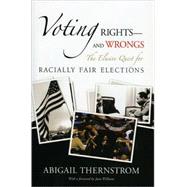
| Acknowledgments | p. xi |
| Foreword | p. xiii |
| Introduction | p. 1 |
| Unconquered Territory | p. 4 |
| The Constitutionally Daring Design | p. 5 |
| Racism Wanes while Federal Power Expans | p. 7 |
| A Disconnection from Reality | p. 9 |
| The Constitutional Order Distorted-By Necessity | p. 11 |
| The Importance of Black Legislators | p. 13 |
| A Partial Truth | p. 15 |
| Expected and Unexpected Results | p. 17 |
| A Medley of Normative Questions | p. 21 |
| The Fundamentals | p. 25 |
| The Orginal Design | p. 26 |
| The Emergence of Section 5 | p. 31 |
| The Amendments of 1970 | p. 34 |
| Amended Again in 1975 | p. 36 |
| An Imaginative Solution to a Problem | p. 38 |
| Section 2 Rewritten | p. 41 |
| Combating Southern Racism: The Forgotten Goal | p. 44 |
| Interpreting Section 5: The Mess the Courts Have Made | p. 47 |
| Allen v. State Board of Elections | p. 49 |
| Discrimination Redefined | p. 53 |
| The Annexation Cases | p. 54 |
| Beer v. United States | p. 58 |
| Bossier I | p. 61 |
| Bossier II | p. 64 |
| Ashcroft | p. 66 |
| Unresolved Issues | p. 70 |
| Interpreting Section 2: Judges Lost in a Political Thicket | p. 73 |
| Assessing Racial Equality | p. 74 |
| Whitcomb v. Chavis | p. 77 |
| White and Zimmer | p. 78 |
| Bolden and the 1982 Amendments to Section 2 | p. 80 |
| Thornburg v. Gingles: The Court Weighs In | p. 84 |
| O'Connor's Concurrence | p. 87 |
| Three Preconditions | p. 89 |
| The Totality of Cicrumstances | p. 97 |
| A Statute in Search of a Theory | p. 106 |
| Divvying Up | p. 109 |
| Section 5 Enforcement: The Mischief That Government Bureaucrats Can Make | p. 111 |
| The Roadblocks Ahead | p. 112 |
| A Law Office Working for Minority Plaintiffs | p. 114 |
| No Discernible Standards | p. 117 |
| The 1980s: Detours around Retrogression | p. 120 |
| The 1990s: A Lawless Civil Rights Division | p. 124 |
| John Dunne's Section 5 | p. 127 |
| Merging Sections 5 and 2 | p. 130 |
| Detailed Data and Sophisticated Software | p. 133 |
| The Justice Department Memo | p. 135 |
| The Fog | p. 139 |
| The Fourteenth Amendment Cases: Trafficking in Racial Stereotyping | p. 143 |
| Miller | p. 148 |
| Post-Miller | p. 151 |
| Misguided Hyperbole | p. 154 |
| The View from the Academy | p. 156 |
| Race-Districts: A Defective Hybrid | p. 159 |
| Expressive Harms | p. 162 |
| A Rorschach Test | p. 164 |
| The Serbonian Bog | p. 167 |
| Competing Principles | p. 170 |
| The 2006 Voting Rights Act | p. 179 |
| Dueling House and Senate Reports | p. 178 |
| Revisiting Section 2 | p. 182 |
| Waiting for NAMUDNO: Section 5 in Jeopardy | p. 187 |
| How Much Has the South Changed? | p. 191 |
| Debate among Scholars | p. 196 |
| Conclusion: Moving On | p. 199 |
| A Period Piece | p. 202 |
| From a Biracial to a Multiracial Polity | p. 203 |
| Section 2: What Next? | p. 206 |
| Whither Section 5? | p. 209 |
| Racial Progress Stymied | p. 214 |
| In Conclusion | p. 220 |
| p. 225 | |
| Jurisdictions Covered by Section 5 of the Voting Rights Act | p. 225 |
| p. 229 | |
| The Voting Rights Act of 1965 | p. 229 |
| Fannie Lou Hamer, Rosa Parks, and Coretta Scott King Voting Right Act Reauthorization and Amendments Act of 2006 | p. 239 |
| Notes | p. 243 |
| Index of Voting Rights Cases | p. 303 |
| General Index | p. 307 |
| About the Authors | p. 315 |
| Table of Contents provided by Ingram. All Rights Reserved. |
The New copy of this book will include any supplemental materials advertised. Please check the title of the book to determine if it should include any access cards, study guides, lab manuals, CDs, etc.
The Used, Rental and eBook copies of this book are not guaranteed to include any supplemental materials. Typically, only the book itself is included. This is true even if the title states it includes any access cards, study guides, lab manuals, CDs, etc.